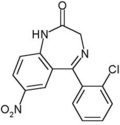Mumtaz Siddiqui, MD; Nazih N Kadri, MD; Tom T Hee, MD(*); Karen S Rovang, MD; Timothy Ryan, RN; Daniel Hilleman, PhD; Aryan N Mooss, MD and Syed M Mohiuddin, MD. Cardiology, Creighton University School of Medicine, Omaha, NE.
PURPOSE: Clonazepam has been shown to be effective in the treatment of neurocardiogenic symptoms. However its role in the treatment of neurally mediated symptoms (NMS) in patients (pt) with chronic fatigue syndrome (CFS) has not been investigated.
METHODS: Thirteen pt (3 male, 10 female, age range 14-53 years) with diagnosed CFS and had associated NMS were referred to the Creighton University Cardiac Center. NMS included but were not limited to orthostatic presyncope (8/13 pt), weakness (13/13 pt), exercise intolerance (13/13 pt), and the inability to participate in day to day activity normal for age and gender (13/13 pt). NMS were reproduced by head up Tilt Table study (HUT) in 13/13 pt. Ten of 13 pt had abnormal HUT. These pt were given Clonazepam at 0.25 mg-0.75 mg/d (mean 0.41 mg/d).
RESULTS: Orthostatic presyncope episodes decreased from a daily occurrence to 0-2 episodes per month in 7/8 pt. Twelve of 13 pt had significant reduction of NMS and were able to resume normal lifestyles. Six of 10 pt had a normal response to HUT while 3/10 pt had significant improvement in HUT duration. One of 13 pt failed HUT and failed to have significant clinical improvement. Clonazepam side effects included initial early morning sedation in all pt. Late side effects included chest discomfort in one pt (noncardiac), and excessive sedation in 2 pt which subsided with dose reduction.
CONCLUSION: Clonazepam, a centrally acting medication, in a small well tolerated dose (0.25-0.75 mg /d) is clinically effective in the treatment of NMS occurring in pt with CFS. Prospective placebo controlled studies are needed to confirm these findings.
CLINICAL IMPLICATIONS: Therapy for neurocardiogenic syncope has traditionally included beta blockers, SSRIs, disopyramide, and volume expansion. Clonazepam can be added to the list of potentially useful drugs for neurocardiogenic syncope.
COPYRIGHT 2000 American College of Chest Physicians
COPYRIGHT 2001 Gale Group



